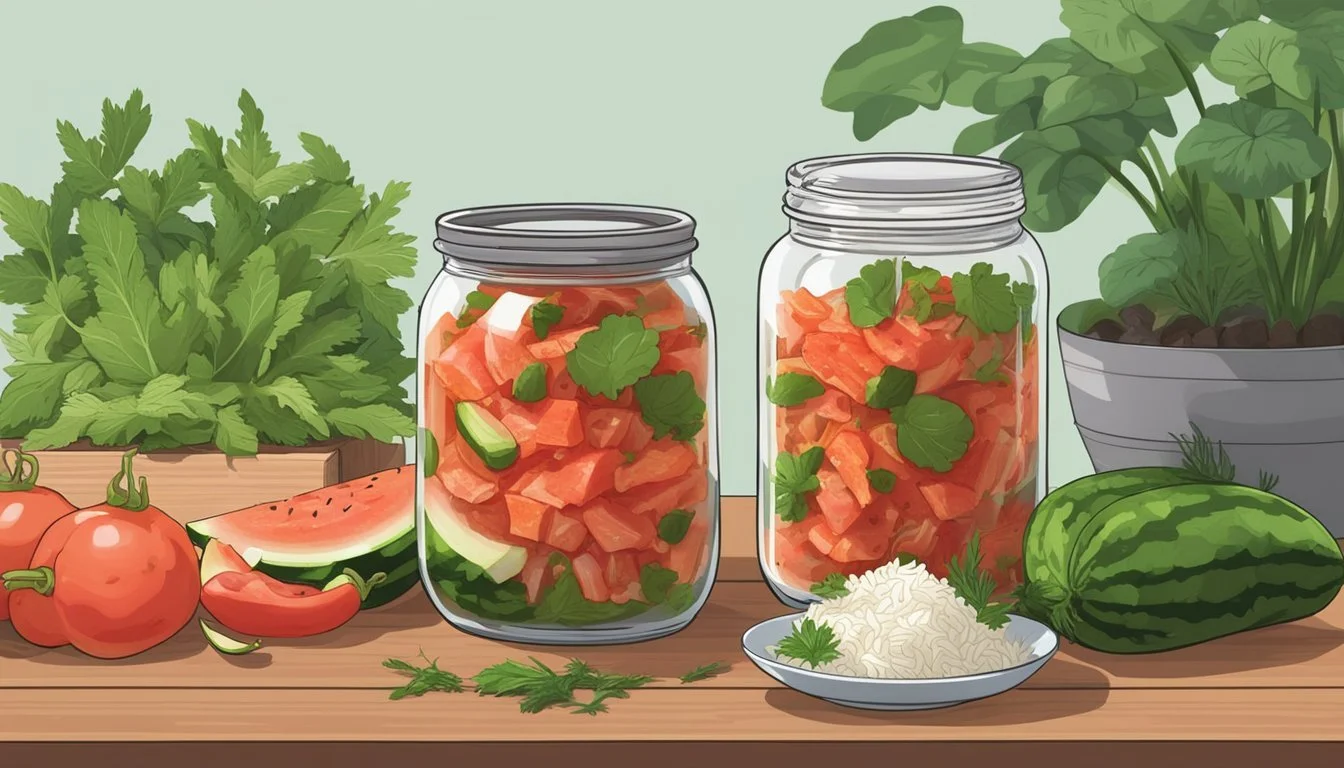Watermelon Rind Kimchi
Unleash the Flavors of a Unique Fermented Delight
Watermelon rind kimchi, traditionally known as a Korean side dish, has garnered attention for its unique twist on the classic kimchi preparation. This innovative condiment takes the often-discarded part of the watermelon and transforms it into a spicy, fermented creation. It exemplifies a zero-waste approach to cooking, showing respect for ingredients by utilizing the entire fruit. This shift towards sustainability is matched by the dish’s robust flavors, making it a staple for those looking to reduce waste without compromising on taste.
The preparation of watermelon rind kimchi involves salting and fermenting the inner white part of the watermelon rind, which is often overlooked. The rind, once properly prepared, is combined with a blend of spices including ginger, garlic, and chile flakes, infusing it with the signature heat that kimchi is famous for. The fermentation process not only amplifies the spicy and tangy profile of the kimchi but also contributes to the development of beneficial probiotics.
Fermentation, a method prized in Korean cuisine, is an essential aspect of creating authentic watermelon rind kimchi. This time-honored technique allows natural bacteria to proliferate, turning simple ingredients into a complex and flavorful condiment. It is this careful balance of fermentation and seasoning that renders watermelon rind kimchi a vibrant and healthy addition to any meal, offering a spicy kick and a testament to the ingenuity of culinary traditions that find treasure in the overlooked.
The Origin of Watermelon Rind Kimchi
Watermelon rind kimchi is a creative adaptation of traditional Korean kimchi, marrying the age-old fermentation techniques with the often-discarded parts of watermelons. This section explores its roots in Korean culinary customs and traces how this novel variation conforms to sustainable gastronomy trends.
Korean Kimchi Tradition
Kimchi is one of the hallmarks of Korean cuisine, with history stretching back thousands of years. It involves fermenting vegetables with a mixture of seasonings, such as garlic, ginger, and chili peppers. The traditional method aims to preserve vegetables for off-season consumption while enhancing their flavors and nutritional value. Over the centuries, various regions in Korea have developed their own unique styles and versions of kimchi.
Adaptation to Watermelon Rinds
Watermelon rinds, typically a byproduct in the consumption of the popular summer fruit, have found an innovative use in the making of kimchi. By applying the age-old Korean fermentation practices to watermelon rinds, this version of kimchi recasts an otherwise discarded ingredient into a delicacy. The adaptation to watermelon rinds is a testament to the versatility and sustainability inherent in Korean culinary philosophy, creating a condiment that is both unique and respectful of food resources.
Health Benefits
Watermelon rind kimchi combines the nutritious profile of watermelon rinds with the distinctive qualities of fermentation, delivering a condiment that is not only flavorful but also offers various health benefits.
Nutritional Value of Watermelon Rind
The watermelon rind is the white part of the watermelon between the outer green skin and the inner red flesh. Often discarded, the rind actually contains health-promoting nutrients. Watermelon rind is rich in:
Vitamin C: Important for immune function and skin health.
B-vitamins: Play a vital role in energy production.
Potassium: Essential for heart and muscle function.
Dietary fiber: Aids in digestive health.
Benefits of Fermented Foods
Fermented foods (What wine goes well with fermented foods?) like kimchi undergo a natural process where beneficial bacteria break down food components. This fermentation results in:
Probiotics: They support gut health by improving the balance of beneficial bacteria.
Enhanced Nutrient Absorption: The fermentation process can increase the bioavailability of minerals.
Reduced Inflammation: Ingredients in kimchi such as garlic and ginger have anti-inflammatory properties.
Focusing on watermelon rind kimchi, one can enjoy a unique blend of nutrients from watermelon rind, heightened by the advantageous process of fermentation which may support weight management and boost overall well-being.
Preparation Basics
Making Watermelon Rind Kimchi involves careful preparation of the watermelon, starting with selecting the best fruit and ensuring the rind is properly cleaned and peeled. Attention to these details is crucial for the success of the final dish.
Selecting Quality Watermelons
One should look for watermelons that are firm, symmetrical, and free of bruises, cuts, or dents. A creamy yellow spot on the underside indicates that the watermelon rested on the ground and ripened in the sun. The heaviness of the watermelon is also a sign of juiciness, which is essential for quality rinds that will ferment well into kimchi.
Proper Cleaning and Peeling Techniques
Once a suitable watermelon is selected, the next steps are:
Cleaning: Rinse the whole watermelon under cold running water to remove any surface dirt and potential bacteria. Dry it thoroughly with a clean towel.
Peeling: Cut the watermelon into slices and trim off the pink flesh. One should then remove the green skin of the watermelon rind, leaving behind the white part that will be used for the kimchi.
The peel is best removed using a sharp kitchen knife or a sturdy vegetable peeler. This technique ensures no parts of the hard, inedible green skin remain, which might affect the texture and fermentation process.
Ingredients and Substitutes
Watermelon rind kimchi requires specific ingredients to achieve its unique flavor profile, but substitutions can be made to cater to dietary needs without compromising the dish's integrity.
Essential Ingredients for Authentic Flavor
The bold taste of watermelon rind kimchi is typically achieved with the following ingredients:
Watermelon Rind: The star of the dish, utilizing the white part of the watermelon.
Sea Salt: Used to draw out moisture and add flavor.
Gochugaru (Korean chili flakes): Provides the quintessential heat.
Garlic and Ginger: Essential for depth and aromatic qualities.
Fish Sauce: Adds complexity and umami flavors.
Sugar: Balances the heat and aids in the fermentation process.
Sesame Seeds: Often used as a garnish for extra texture and a nutty taste.
Fresh, high-quality ingredients yield the best results in creating a rich, flavorful kimchi.
Substitutions for Dietary Restrictions
For those with specific dietary concerns, the following substitutes may be employed:
Traditional Ingredient Substitute Reason for Use Fish Sauce Soy Sauce or Seaweed Broth To accommodate vegetarian or vegan diets. Sugar Maple Syrup or Agave Nectar For a natural sweetener option. Gochugaru Smoked Paprika combined with Red Pepper Flakes To adjust heat levels or if gochugaru is not readily available.
It is crucial to note that substitutions may slightly alter the taste profile but can still produce a delicious and satisfying condiment.
Step-by-Step Recipe
This section provides a detailed recipe for Watermelon Rind Kimchi, guiding the reader through the preparation of the rinds, crafting the seasoning paste, the fermentation process, and effective storing techniques to preserve the kimchi.
Preparing the Watermelon Rinds
To start, one must carefully prepare the watermelon rinds. The green outer skin should be removed and discarded, leaving only the white part. The white rinds are then thinly sliced or chopped into small pieces, depending on the desired texture. The prepared rinds are then placed in a wide bowl and sprinkled generously with coarse sea salt. They should be tossed to ensure the salt is evenly distributed. Afterwards, the rinds are covered with a wrap and left at room temperature for an hour, with an initial flip after 30 minutes.
Mixing the Seasoning Paste
While the rinds are salting, the seasoning paste can be prepared. A blend of key ingredients including garlic, ginger, and a sugar source, often combined with fish sauce for umami depth, is mixed with gochugaru (Korean red pepper flakes) to create the base of the paste. Each ingredient should be measured and mixed thoroughly until a paste forms. This spice-infused base will be mixed with the watermelon rinds to create the kimchi's distinctive flavor.
Fermentation Process
After the rinds have been salted and rinsed to remove excess salt, the prepared paste is added to the rinds. The ingredients are mixed until the rinds are well coated with the seasoning. The kimchi is then transferred to a clean glass container, which allows for an anaerobic environment conducive for fermentation. The container should be sealed tightly and left to ferment at room temperature for a few days, allowing the flavors to develop complexity and the rinds to achieve a pleasing, crunchy texture.
Storing and Preservation
Upon reaching the desired level of fermentation, the kimchi should be transferred to the refrigerator to slow down the fermentation process and preserve it for longer-term consumption. The cold environment restricts microbial activity, thereby preserving the kimchi's freshness and extending its shelf life. Properly stored watermelon rind kimchi can be incorporated into a variety of kimchi recipes and enjoyed as an accompaniment to meals.
Serving and Pairing Suggestions
When it comes to enjoying Watermelon Rind Kimchi, it's not just about the taste—it's about how one serves it and what dishes complement it to enhance the dining experience.
How to Serve Watermelon Rind Kimchi
Watermelon Rind Kimchi can be served as a side dish in a small bowl alongside main courses. This spicy, fermented condiment is often enjoyed in small amounts due to its strong flavor. For an ideal snacking option, it can also be offered on a platter with other Korean food (What wine goes well with Korean food?) selections such as bulgogi or bibimbap.
Dishes Perfect for Kimchi Pairing
Watermelon Rind Kimchi pairs well with a variety of dishes, both Korean and non-Korean. Here's a list of dishes that are elevated by its distinct spicy and tangy flavor:
Rice Dishes: A scoop of kimchi adds zest to plain rice or fried rice.
Grilled Meats: Complements the richness of meats like pork belly (What wine goes well with pork belly?) or beef short ribs. (What wine goes well with beef short ribs?)
Stews and Soups: Enhances the warmth and depth of flavor in Korean stews like sundubu-jjigae.
Noodles: Provides a crunchy texture contrast to noodle dishes such as japchae.
Tips and Tricks for Perfect Kimchi
When crafting watermelon rind kimchi, precision in preparation and seasoning leads to a condiment that perfectly complements a variety of dishes with its crunchiness and balanced heat.
Achieving the Perfect Crunch
To ensure crunchiness in watermelon rind kimchi, one should carefully select and prepare the rinds. The rinds are where the textural contrast is at its peak, contributing to the unique characteristics of the kimchi. Here are specific steps to follow:
Preparation: Remove the green outer skin and use only the white part of the watermelon rind.
Salting: Salt the rind slices and let them sit at room temperature.
First sitting: 30 minutes, then toss.
Second sitting: An additional 30 minutes after tossing.
Rinsing: Before seasoning, rinse the rinds under cold water, then drain to remove excess salt.
Balancing Spices and Flavors
A harmonious blend of spices and flavors is crucial for creating a spicy yet palatable watermelon rind kimchi. To balance these tastes:
Begin with a foundation of salt to aid in fermentation.
Incorporate gochugaru (Korean red pepper flakes) to impart the classic kimchi heat.
Add aromatics like minced garlic and ginger for depth.
For sweetness, consider natural options like green plum syrup, often used in Korean cuisine.
Mix in a concoction of soy sauce, rice vinegar, and a small amount of sugar to achieve a complex flavor profile.
It's essential to taste as one goes, adjusting the level of each spice to suit personal preferences and to create a consistent, flavorful result.
Innovative Uses for Watermelon Rind Kimchi
Watermelon Rind Kimchi is not only a vibrant condiment but also a versatile ingredient that brings a creative spark to an array of dishes. Below, explore how it can be adapted to suit both familiar and new culinary creations.
Creative Culinary Ideas
One can enhance many traditional watermelon rind recipes with the zesty flavors of kimchi. This condiment can be:
Transformed into a dip: Puree kimchi to serve as a spicy dip for vegetables or chips.
Blended into dressings: Whisk kimchi with olive oil, vinegar, and honey for a unique salad dressing.
Incorporation into Western Dishes
The bold taste of Watermelon Rind Kimchi can complement the American palate by giving a twist to classic recipes:
Added to a smoothie: For a gutsy start to the day, blend kimchi into a smoothie, balancing its heat with sweeter fruits.
Fashioned into a relish: Mix it into a relish that can add a kick to hot dogs, burgers, or grilled cheese sandwiches.
Sustainability and Zero-Waste Cooking
In the context of zero-waste cooking, using watermelon rinds to make kimchi is not only sustainable but also a flavorful way to reduce food waste. This approach aligns with eco-friendly practices by utilizing parts of produce that are typically discarded.
Benefits of Using the Whole Watermelon
Using the entire watermelon, including the rind, maximizes the fruit's value and minimizes waste. The rind, often overlooked, is a crunchy and nutritious ingredient that lends itself well to fermentation in dishes like kimchi.
Nutritional value: The rind contains citrulline and fiber.
Flavor enhancement: The subtle sweetness complements the spicy kimchi seasoning.
Waste reduction: By using the rind, the entire watermelon is utilized.
Contributing to a Sustainable Food System
Incorporating watermelon rinds into kimchi fosters a more sustainable food system.
Zero waste: This practice supports a zero-waste lifestyle, reducing landfill burden.
Resource efficiency: It allows for more efficient use of resources, as watermelon rinds are transformed into a value-added product rather than being treated as refuse.
Awareness and education: Sharing such recipes can spread awareness of sustainability in food choices, demonstrating how easily one can repurpose what is usually thrown away.
Making watermelon puree from the flesh and using it in the kimchi recipe further ensures that no part of the fruit goes to waste. In this way, watermelon rind kimchi serves as a delicious testament to the principles of zero-waste and sustainability.
Frequently Asked Questions
What is watermelon rind kimchi?
Watermelon rind kimchi is a spicy, fermented condiment. It repurposes the often-discarded white part of the watermelon rind, infusing it with traditional kimchi flavors.
How do you prepare watermelon rind for kimchi?
One begins by removing the outer green skin of the watermelon rind and retaining only the white part. This is then thinly sliced or cubed, depending on preference.
Does watermelon rind need to be pickled before fermentation?
Yes, the sliced or cubed watermelon rind is typically salted to draw out water, which starts the pickling process. Afterward, it's rinsed and mixed with a variety of spices for fermentation.
Can I use a jar for fermenting watermelon rind kimchi?
Absolutely. A clean jar is ideal for fermenting kimchi. Ensure that it is sufficiently aerated during the fermentation process to prevent the build-up of gases.
How long should watermelon rind kimchi ferment?
The fermentation time can vary, but generally, it ferments for several days at room temperature. Afterward, it should be stored in the refrigerator to slow down fermentation.
What are the health benefits of watermelon rind kimchi?
Just like traditional kimchi, watermelon rind kimchi is rich in probiotics. It's also a low-waste food option, utilizing parts of the fruit that would otherwise be discarded.
Is watermelon rind kimchi vegan?
Traditional kimchi recipes may include fish sauce or shrimp paste. To make it vegan, one can substitute with soy sauce or miso paste when preparing the seasoning mix for the watermelon rind kimchi.
Conclusion
The preparation and enjoyment of watermelon rind kimchi represent a creative and eco-friendly approach to culinary practices. This condiment showcases the versatility of watermelon rinds, transforming what is often discarded into a flavorful and nutritious dish. The tangy and spicy flavors are testament to the ingenuity inherent in traditional fermentation techniques, which not only preserve the produce but also enhance its taste.
Home cooks are encouraged to experiment with this kimchi variant, adapting the spiciness to individual palates, and finding pleasure in the unique texture and flavor that watermelon rinds contribute to the mix. The practical steps involved in making watermelon rind kimchi prompt culinary enthusiasts to engage with the process mindfully, appreciating the importance of each ingredient and the value of food sustainability.
They can find fulfillment in the knowledge that no part of the watermelon goes to waste. This prepares them to be more conscious and resourceful in their cooking endeavors. As a result, watermelon rind kimchi is not just a delight to the taste buds but also a positive step towards more responsible food consumption practices.
To aspiring kimchi makers, take this as an affirmation: with the right ingredients and a touch of patience, one can easily turn watermelon rinds into a delectable condiment. This endeavor serves as a worthwhile addition to one's culinary repertoire, proving that sustainable food choices can lead to extraordinary delights on the dining table.






